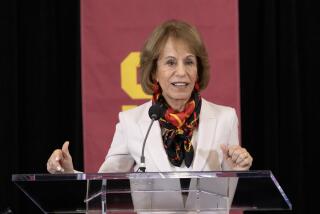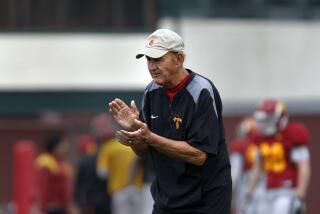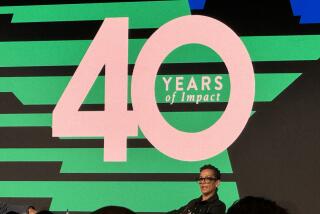Anthony Lazzaro, who helped USC grow into a sprawling bastion of research, dies
- Share via
Anthony Lazzaro, a longtime USC administrator who guided the rapid expansion of the university’s campus and helped make USC central to the 1984 Olympics, has died at his home in Palos Verdes Estates.
Lazzaro died Thursday of natural causes, his family members said. He was 100.
During his 42-year tenure with USC — first as an assistant business manager and eventually climbing the ranks to university vice president and special advisor to the president in 1988 — Lazzaro was responsible for the construction of 132 university buildings, growing USC from a small commuter campus with no clearly defined boundaries to the sprawling bastion of research it is today.
Lazzaro also served as chief liaison officer with the 1984 Los Angeles Olympic Organizing Committee, negotiating more than $19 million in agreements that turned USC into a major Olympic Games venue.
“Anthony Lazzaro virtually built the USC we know today ... No single individual has had more impact on the development of this university,” former USC President James H. Zumberge said of Lazzaro shortly before his retirement in 1991.
Lazzaro was born in Utica, N.Y., on Jan. 31, 1921, to Italian immigrant parents. As a young man, he worked for Western Union, where Lazzaro’s boss asked him to change his Italian last name if he wanted to continue working for the company, according to his daughter, Nancy Lazzaro. He refused.
Lazzaro was called to active U.S. Navy duty shortly after the start of World War II and the attack on Pearl Harbor. He became chief engineer of the USS DuPage, on which he survived a Japanese kamikaze attack in 1945 that killed three dozen men. Lazzaro was discharged as a lieutenant and moved to L.A., where he used his G.I. Bill funds to enroll at USC as an industrial engineering student.
His greatest ambition before attending USC was to be a manager of a power plant. “Coming from a working-class background, that was what he thought he could achieve,” said Lazzaro’s grandson, Derek Lazzaro. “USC was the first time he ever saw a world beyond working in industrial conditions.”
After graduating in 1949, Lazzaro began working for USC as an assistant business manager and superintendent of buildings and grounds. At the time, the university had just 11 permanent buildings and 27 U.S. Army barracks — which initially served as housing for USC’s naval preparatory flight cadet school during WWII — that were converted into classrooms and offices.
USC’s 1960 “Master Plan” called for expanding the campus from 57 to 160 acres and pushing its boundaries to Vermont Avenue, Figueroa Street, Exposition and Jefferson boulevards, a massive undertaking overseen by Lazzaro.
“We had other objectives in mind — not simply the expansion of the university, the campus. We had in mind the revitalization of the community,” Lazzaro said in a 1990 interview during which he described the master plan’s urban renewal efforts, which included making neighboring streets more pedestrian-friendly.
During Lazzaro’s tenure as chief of capital construction, USC also acquired the land for and built its Health Sciences Campus — bordered by Boyle Heights and Lincoln Heights — in the early 1950s.
Lazzaro’s passion for improving USC and the experience of its students superseded all else in his life, other than his family, his grandson said. He survived seven USC presidents, a feat in the world of academia in which administrative transitions can often lead to layoffs and reshufflings.
“He expected a lot from people. Had very high standards, both in professional life and personal and family life,” Derek Lazzaro said. “At the same time, he was also forgiving. He told me he hardly ever fired anyone in his whole career.”
Lazzaro is survived by daughter, Nancy Lazzaro, and his grandsons, Derek and Anton Lazzaro. His wife of several decades, Shirley Jones Lazzaro, died in 1995.
More to Read
Sign up for Essential California
The most important California stories and recommendations in your inbox every morning.
You may occasionally receive promotional content from the Los Angeles Times.











